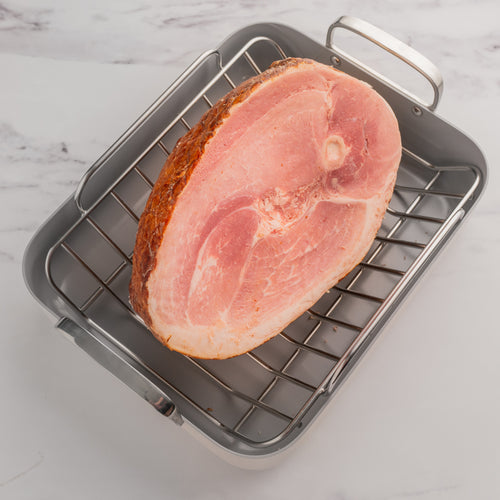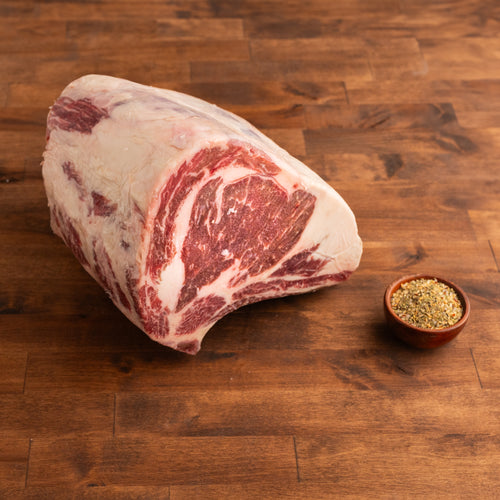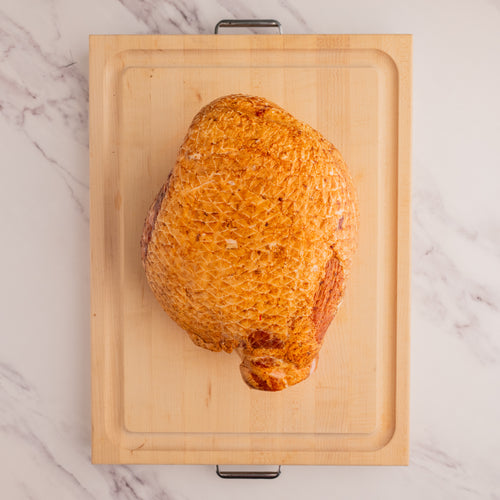How to Defrost a Ham or Roast - Safe and Easy Thawing Tips

How to Thaw Large Cuts: Roasts and Hams
At Snake River Farms, we know that properly thawing a roast or ham is just as important as cooking it to perfection. If you’ve got one of our premium cuts in your freezer, taking the time to thaw it the right way ensures the best flavor, texture, and food safety.
Watch this quick video for expert tips on safely thawing your SRF roasts and hams:
|
Table of Contents |
Expert Tips for Thawing Wagyu Roasts and Kurobuta Hams
We take pride in delivering the highest quality Wagyu roasts and Kurobuta hams, which is why we use a flash-freezing process to lock in freshness. If you’re wondering about the difference between fresh and frozen cuts, check out our article on Fresh vs Frozen Meat. By quickly freezing our products at -20°F, we preserve the rich marbling, tender texture, and incredible flavor you expect from Snake River Farms.
When it’s time to thaw your roast or ham, doing it the right way is crucial—not just for taste but for food safety, too. Here’s what you need to know:
Avoid the “ danger zone”: Food safety is our top priority, and that’s why we emphasize keeping your meat out of the “danger zone” (between 40°F and 140°F), where bacteria thrive. Never thaw your roast or ham at room temperature, as this can leave the outer layers vulnerable to bacteria while the inside remains frozen.
For a foolproof guide on how to safely handle and prepare your ham, from thawing to cooking, check out our full step-by-step guide on safely handling and preparing your ham, from thawing to cooking, check out our Ham Temperature Guide.
Here are key thawing tips to ensure safety and quality:
-
Avoid using hot water: While it might speed up the thawing process, hot water pushes the temperature into the danger zone, which can create serious food safety risks.
-
Never thaw at room temperature: Even if it seems easier, the exterior thaws first, which can allow bacteria to grow before the center of the roast or ham is fully defrosted.
-
Be careful with room temperature resting: Some recipes suggest letting your roast sit out to warm up before cooking. If you choose to do this, never leave it out for more than 2 hours—any longer, and it enters the danger zone.
-
Follow these safe thawing methods: We recommend thawing slowly in the refrigerator for the best results (and we’ll break down exactly how to do that below). If you're in a hurry, there are faster but still safe options, which we’ll cover as well.
By planning ahead and thawing your roast or ham the right way, you’ll keep it safe and preserve the exceptional quality we’re known for.
The Best Way: Thawing Roast and Hams in the Refrigerator
If you’re wondering when to take a ham out of the fridge, the key is to plan ahead. For the best results, thaw Snake River Farms roasts and hams in the refrigerator at a temperature below 40°F. This method is the safest and ensures your roast or ham retains its rich flavor, tenderness, and signature texture.
"For best quality, beef should be frozen fast and thawed slowly. Thawing at refrigerated temperatures allows ice crystals to melt with minimal cell damage to the meat."Jeff Sewell, Dean of Texas A&M’s Meat Science Department
Once thawed, you can learn the best way to cook your ham by reading our Guide on How to Cook a Ham.

How Long does it Take for a Roast or Ham to Thaw in the Fridge?
For a large item, the time to completely thaw can be a matter of days. The USDA guidelines say to allow 24 hours for each 5 pounds of product. This means a 20-pound ham can take 4 or more days to completely thaw.
To be safe, add an extra day or two to the thawing time. Once thawed, all Snake River Farms retain their freshness for up to 7 days. If you’re wondering what to do with leftovers, be sure to check out our article on Leftover Ham: The Start to Something Delicious.
How to thaw a ham or roast in the refrigerator
-
Keep it wrapped: Leave your roast or ham in the original packaging.
- Use a tray: place it on a baking sheet or in a shallow dish to catch any drips or condensation.
-
Let it rest: Set it in the refrigerator and allow it to thaw completely.
Pro tip: Once your ham or roast is fully thawed, you can safely keep it in the refrigerator for up to 7 days before cooking.
Once thawed, you can learn the best way to cook your ham by reading our Guide: How to Cook a Ham or check out our How to Smoke a Ham guide for a smoky twist.
Faster Ways to Thaw Roasts and Hams
If you're short on time, these faster thawing methods can get your roast or ham ready—though we always recommend planning ahead for the best results.
1. Cold Water Thawing
When there’s not enough time to thaw a roast or ham in the refrigerator, cold water thawing is your best option. It’s faster but requires attention to maintain food safety.
Here’s how to do it:
- Check for Leaks: Ensure your roast or ham is tightly sealed. If there’s a leak, transfer it to a leak-proof package or plastic freezer bag to prevent bacteria contamination and water absorption.
- Submerge in Cold Water: Place the roast or ham in cold tap water—never use hot water as it can push the temperature into the "danger zone," where bacteria thrive.
- Change Water Regularly: Change the water every 30 minutes to ensure even thawing. It takes about 30 minutes per pound of product.
-
Cook Immediately: Once thawed, cook the product right away to prevent any food safety issues.
2. Thawing Prime Rib or Ham in the Microwave (Last Resort)
If you're really pressed for time, the microwave method is an option—but it should be reserved for emergencies. While it will thaw your meat quickly, it can alter the texture and flavor, as the microwave also partially cooks the meat.
Here’s how to do it:
-
Check Frequently: Use the microwave's defrost setting and check the product often to ensure it’s only thawing, not cooking.
- Cook Immediately: Once thawed, cook the roast or ham right away to avoid any food safety concerns.
Can I Cook a Frozen Ham or Roast Without Defrosting First?
We do not recommend cooking a frozen ham or roast without thawing it first. While it is technically possible, it will take about 1.5 times longer to cook, and the results may not be as flavorful or evenly cooked. The texture could be impacted as well.
For the best flavor, texture, and even cooking, always thaw your meat in the refrigerator before cooking. Thawing first is the ideal method to ensure the best results and food safety.
Always plan Ahead When it Comes to Thawing your Roast or Ham
To ensure your roast or ham is perfectly thawed and ready for your big meal, make sure to plan ahead and allow plenty of time. Thawing slowly in the refrigerator is the safest and most effective method for preserving flavor and texture.
As a final reminder, never thaw your meat in places with uncontrolled temperatures such as the garage, basement, car, outdoors, or on the kitchen counter. These environments can increase the risk of bacteria growth and compromise food safety.

Thawing Tips and Tricks from Snake River Farms
Thawing your roast or ham the right way is the first step to an incredible meal. By planning ahead and using safe thawing methods—like refrigerator thawing for the best quality or cold water thawing when you're short on time—you’ll preserve the rich flavors and tender texture of our premium cuts. Avoid common pitfalls like room temperature thawing or hot water methods to keep your meal both safe and delicious.
Ready to put your newfound knowledge to the test? Explore our selection of Wagyu roasts and Kurobuta hams and elevate your next meal with the finest cuts from Snake River Farms. Shop Kurobuta Roast and Wagyu Roasts.







